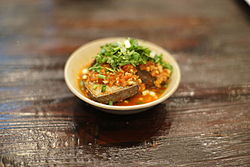Guilin
Guilin is a prefecture-level city in the northeast of the Guangxi Zhuang Autonomous Region, China.[1] It is on the west bank of the Li River. It is next to Hunan to the north. Its name means, "Forest of Sweet Osmanthus". This is due to the large number of fragrant Sweet Osmanthus trees grown throughout the city. It has long been renowned for its scenery of karst rock formations.[1] It has crystal clear (meaning as clear as glass) waters and many caves to explore.[1] Guilin is one of China's most popular tourist destinations. It was the first city open to tourism[2] after 1949.[3] There are many tours including photographic tours.[4]
Guilin covers an area of 27,800 square kilometres (10,700 sq mi).[1] It has a total population of about 5.3 million people.
Guilin Media
Statue of Ma Yuan at Fuboshan, Guilin.
Streets of Guilin during World War II
Map including Guilin (labeled as 桂林 KUEI-LIN (KWEILIN) (Walled)) (AMS, 1954)
A BYD K8S double decker bus operating in Guilin
References
- ↑ 1.0 1.1 1.2 1.3 "Guilin Travel Guide". Travel China Guide. Retrieved 22 September 2015.
- ↑ "Guilin Tours - Best Tour Packages For Guilin, China in 2020". Discover China. Retrieved 2020-01-25.
- ↑ "Guìlín China". Lonley Planet. Retrieved 22 September 2015.
- ↑ "Top Private Tours in Guilin". Trip Advisor. Retrieved 22 September 2015.
Other websites
- Guilin Travel Guide Archived 2015-05-05 at the Wayback Machine
- Guilin Photo Gallery










